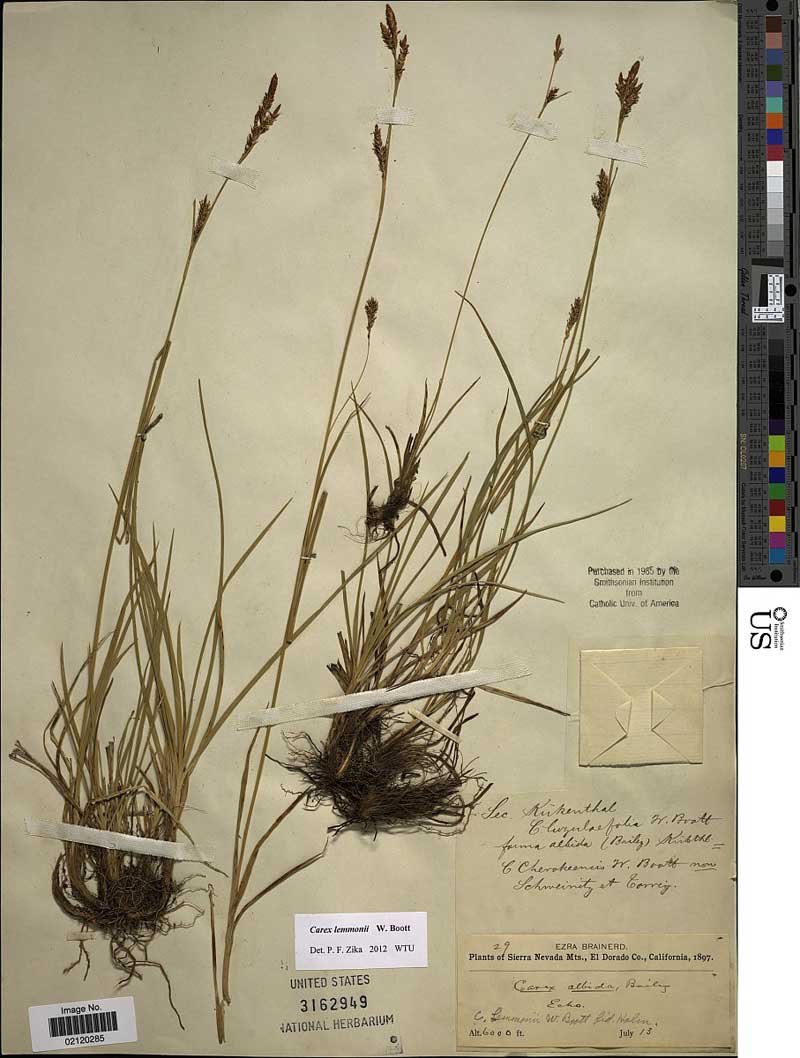
Classification System: APG IV
Superregnum: Eukaryota
Regnum: Plantae
Cladus: Angiosperms
Cladus: Monocots
Cladus: Commelinids
Ordo: Poales
Familia: Cyperaceae
Subfamilia: Cyperoideae
Tribus: Cariceae
Genus: Carex
Species: Carex lemmonii
Name
Carex lemmonii W.Boott, Bot. Gaz. 9: 93. (1884)
Synonyms
Heterotypic
Carex albida L.H.Bailey, Mem. Torrey Bot. Club 1: 9. (1889)
Carex abramsii Mack., Bull. Torrey Bot. Club 36: 482. (1909)
Carex luzulifolia f. albida (L.H.Bailey) Kük. in H.G.A.Engler (ed.), Pflanzenr., IV, 20(38): 558. (1909)
Carex sonomensis Stacey, Leafl. W. Bot. 2: 63. (1937)
References
Bott, W. 1884. Botanical Gazette; Paper of Botanical Notes 9: 93.
Govaerts, R. et al. 2021. Carex lemmonii in World Checklist of Selected Plant Families. The Board of Trustees of the Royal Botanic Gardens, Kew. Published online. Accessed: 2021 June 20. Reference page.
International Plant Names Index. 2021. Carex lemmonii. Published online. Accessed: June 20 2021.
Tropicos.org 2021. Carex lemmonii. Missouri Botanical Garden. Published online. Accessed: 20 June 2021.
Carex lemmonii, or Lemmon's sedge, is a plant in the sedge family, and is endemic to California. Carex albida (binomial authority L.H.Bailey) is now considered a synonym, but was previously thought to be a separate species; such plants have the common name white sedge.[2]
Description
This sedge produces a dense or loose clump of erect stems 40 to 60 centimeters tall from a network of short rhizomes. The inflorescence is a cluster of 5 to 7 spikes over 15 centimeters long. Staminate flowers are located mainly on the terminal spike, while pistillate flowers are mainly located in the lateral spikes. The fruit is covered in a sac called a perigynium, which is green with a white beak.
White sedge
White sedge is endemic to Sonoma County, California, where it is known only from one occurrence at Pitkin Marsh, a wetland between Forestville and Sebastopol. There are fewer than 1000 plants,[3] and likely fewer than 300 according to more recent estimates.[4] It is a federally listed endangered species.
The colonies are scattered across 5 acres (20,000 m2) of a 27-acre (110,000 m2) tract.[3][4] As with other plants that reproduce vegetatively by cloning from their rhizomes, the number of true separate individual life forms is hard to estimate, so researchers count visible stems; a recent count revealed fewer than 300, a decrease from nearly 1000.[4] This sedge occurs near a rare local endemic, the Pitkin Marsh lily (Lilium pardalinum ssp. pitkinense).[4]
References
"NatureServe Explorer 2.0".
Zika, Peter F.; Wilson, Barbara L. (October 2012). "Carex albida (Cyperaceae), and its Relationship to Carex lemmonii". Madroño. 59 (4): 171–180. doi:10.3120/0024-9637-59.4.171. S2CID 86232290. Retrieved 1 July 2014.
The Nature Conservancy
USFWS. White sedge/Pitkin marsh lily Five-year Review. August 2009.
Retrieved from "http://en.wikipedia.org/"
All text is available under the terms of the GNU Free Documentation License

